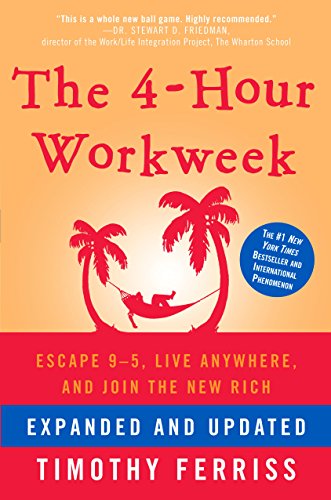Rough notes on 4 Hour Work Week (4HWW) by Tim Ferriss
glossary of terms
DEAL: framework to be more free
NR: new rich
The book is divided into 4 steps and uses the DEAL framework to setup how to be more free.
The following steps are made of the following chapters:
Step I D (definition) 1-4
Step 2 E (elimination) 5-7
Step 3 A (automation) 8-11
Step 4 L (liberation) 12-16
In step 1 (definition) Ferriss talks about defining your goals to be more free.
In chapter 1 the 4HWW book defines the goal which is to be part of the new rich. The New Rich (NR) are more free than Deferrers who defer gratification until they are really old.
In chapter 2 the book talks about some rules to keep in mind when reading the book:
- retirement is not good (it’s boring)
- the New Rich have mini-retirements
- less is not laziness (productivity is more important than busyness)
- the timing is never right (so start now)
- ask for forgiveness, not permission
- emphasize strengths, not weaknesses (when given the choice between the multiplication of results (using strengths) or incremental improvement by fixing weaknesses, choose the former)
- too much in excess is bad
- money alone is not the solution
- relative income is more important than absolute income (currency arbitrage)
- distress is bad, eustress is good (coming from eu the greek prefix for healthy (like in the word euphoria) having a little work stress can be good)
In chapter 3 the author talks about how to define fear and manage it.
In chapter 4 called system reset some points are made:
- unreasonable + unrealistic goals are easier to achieve than small goals
- realistic goals (average ambition) are uninspiring and boring
- adult-onset ADD (adventure deficit disorder) can happen when people are bored and want to adventure
- don’t become like a fat man in a red bmw 🚗
- boredom is the enemy, not some abstract ‘failure’
- get unrealistic using the dreamlining technique
In step 2 (elimination)
Chapter 5 is about time management and starts with a quote from bruce lee: One does not accumulate but eliminate.
Some points are made like:
- Being busy is often a guise for avoiding the few critically important but uncomfortable actions
- employees (intent on remaining employees for now) need to D-E-L-A first because of the environment
- for entrepreneurs the goal is to decrease work whilst increasing revenue (D-E-A-L)
Ferriss mentions the Pareto distribution where 80% of outputs come from 20% of inputs.
He uses the PD to focus from 120 customers to 8 customers.
He also mentions to avoid w4w (work for work’s sake) and that being busy is a form of laziness – where lazy thinking and indiscriminate action are used instead of making a better system.
Ferriss recommends only taking a month or two to ‘throw it up on the wall’ and see what sticks, which means to move forward from a shotgun approach to a more focused plan to get sales or do your job in smarter way.
Ferriss also mentions Parkinson’s law which is the tendency for a task to swell in complexity in relation to the time allotted for it
He also mentions that one should make a to-do list and not-to-do list which includes tips like keeping positive friends and avoiding time-consuming friends
Chapter 6 is about a low info diet 🥑.
Some tips mentioned include to practice nonfinishing.
Chapter 7 is about the art of refusal.
Some tips include to:
- limit email consumption + production
- check email twice per day (once at 12pm, and once at 4pm)
- puppy dog close (Just this once! Please!!! I promise I’ll do X!)
Use the process of batching for time consumers – which means to batch tasks that take alot of time together like maybe reading all emails at 12pm and 4pm instead of constantly checking them throughout the day.
The idea💡 of empowerment failure is mentioned which means being unable to accomplish a task without getting permission. The solution is to avoid micromanagement and trust your employees (as an entrepreneur).
The summary of chapter 7 includes:
- use email instead of face to face meetings to solve problems
- and if meetings are unavoidable then:
- go in with a clear set of objectives
- set an end time or leave early
step 3 (automation)
chapter 8 is about outsourcing life by e.g. using a personal assistant from India
chapter 9 is about income autopilot 1 – finding your muse. 2 important factors are cash flow and time.
some pointers made include:
- creating demand is hard, filling demand is easier.
- start small, think big
- the main benefit should be explainable in one sentence or phrase
- the product should cost the customer $50-200 with a 8-10x markup
- should be fully explainable in a good online FAQ
some options are:
- resell a product e.g. contact manufacturer and request wholesale price-list
- license a product
- create a product (hardware or information product)
chapter 10 is about income autopilot 2 – testing the muse
Intuition and experience are poor predictors of which products/businesses will be profitable.
Ferriss talks about micro-testing your products using e.g. Google’s PPC (pay per click)
Ferriss talks about 1. Market Selection, 2. Product Brainstorm, 3. Micro-testing, and 4. Rollout and automation
chapter 11 is called mba (management by absence).
- some points made are undecision (reducing choices to lessen manufacturing / customer service burden on yourself)
step 5 is liberation
chapter 12 is about how to escape the office
chapter 13 is about making calculated risks
chapter 15 is about why you’re rich and bored
Additional Reading
recommended books include
- magic of thinking big (schwartz)
- the e-myth (gerber) link


Leave a Reply